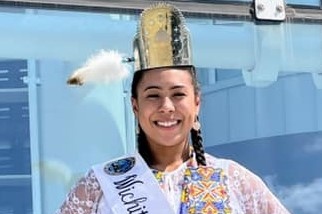
By Isabella Fridia, TYRC Young Leader
Since I was young I have always had a strong interest in STEM (Science, technology, engineering, and mathematics). I participated in the engineering and science fairs in grade school. I even made it to state and received many awards. In high school, I got to learn more complex sciences and math and took a strong interest in Anatomy and Physiology. This has become my passion in college. Currently, I am a sophomore attending the University of Denver majoring in Physiology in Health and Disease. This summer following my freshman year, I wanted to share my passion for science with the next generation. I was able to do this by working as a STEAM (Science, Technology, Engineering, Arts and Math) intern with the Oglala Sioux Tribe child care. It was an amazing experience. I loved working with youth and helping the community.
As STEAM Interns our duties consisted of planning and implementing STEAM activities and networking with other agencies to provide safe and fun summer activities for children. Every day was filled with fun and adventure. In the office, there was a lot of brainstorming and thought that went into our activities. One of my favorite activities was creating balloon cars. The children were given a balloon, straw, a piece of cardboard, two wooden dowels, and four wooden wheels. There were instructions that guided youth on how to construct the cars. Then they could blow in the straw with the balloon attached and watch the balloon car go. This gave young children the opportunity to see how science is all around us and that we can use everyday household items to create and experiment. All of the activities we planned were fun and educational.
I also loved getting involved in the community. We set up several glow walks throughout the districts to raise awareness about the program and get families moving. We provided everyone who came with a neon t-shirt and glowsticks. It was fun to see everyone enjoying
themselves. These community outreach events were a highlight of my time with childcare. There were some bike races for kids as well. With our other resources, we provided bouncy houses and obstacle courses for community events. The youth loved it. During the community Fourth of July celebration, we brought our water slide bouncy houses. It felt good to see all the youth running around happy with smiles. Later in the summer, we got to take some of the youth to Horse Thief Lake outside of Rapid City, SD. Many of them got to Kayak and played on the water. These lake days gave youth exposure to environmental sciences.
Working with childcare this summer was an experience I will never forget. Programming like this is important to serving tribal youth. They give youth a healthy outlet and something to do. One of the greatest concerns of young people on the reservation where I live is that there isn’t anything to do. The Oglala Sioux Tribe Child Care gave youth experiences on and off the reservation to learn and grow. We also sparked an interest in STEAM for our younger relatives. Indigenous people do not have enough representation in STEAM fields. Who knows? Maybe we have created a path for the next inventor, doctor, or mathematician.
Resources
Programs/Events:
AISES | Advancing Indigenous People in STEM
Description: Mission of AISES, as included on their website reads, “The American Indian Science and Engineering Society (AISES) is a national nonprofit organization focused on substantially increasing the representation of Indigenous peoples of North America and the Pacific Islands in science, technology, engineering, and math (STEM) studies and careers.” AISES works with more than 150 K–12 schools (as well as colleges and professionals). Their website provides resources for students, educators, and professionals working with youth in STEM fields, as well as links to partner organizations, scholarships and other opportunities in the field for indigenous youth.
AISES Fairs | National American Indian Science & Engineering Fair
Description: Advancing Indigenous People in Stem (AISES)’s national science fair is “an SSP-affiliated science fair and is the only national science fair centered around acknowledging and supporting indigenous students partaking in science and engineering competitions.”
Email naisef@aises.org for more information.
The Alaska Native Science & Engineering Program – ANSEP: Alaska Native Science & Engineering Program
Description: Located in Anchorage, Alaska, ANSEP’s objective is to “effect systemic change in the hiring patterns of Alaska Natives in science and engineering by placing our students on a career path to leadership. Our goal is to provide an excellent education and a life of unlimited possibilities for every Alaskan.” The organization provides opportunities for youth from elementary school ages through university.
STEM Education for Tribal Youth | EBF Learning Center
Description: EBF Learning Center is a 501(c)3 nonprofit located on the Muscogee (Creek) Nation Reservation in Oklahoma. Their mission is to help improve the lives of Native people, plants and pollinators through innovative community based programs that emphasize capacity building, cultural preservation, and sustainability.
Other Resources:
Description: Article in conversation with “Kathy DeerInWater of the American Indian Science and Engineering Society discussing “the importance of increasing STEM access for Native American students.” Article includes additional links and resources.
Description: As noted on their website, “The ISTEAM collaborative is supporting Indigenous resurgence through (re)making relations with lands, waters, and each other towards just, sustainable, and culturally thriving futures.”
Description: Article that explores in-depth some of the programs included above (e.g., AISES and ANSEP) with applicable links and helpful information.
Description: A 2017 article outlining the accomplishments of and conversations with 18 successful Native folks working in the STEAM field.